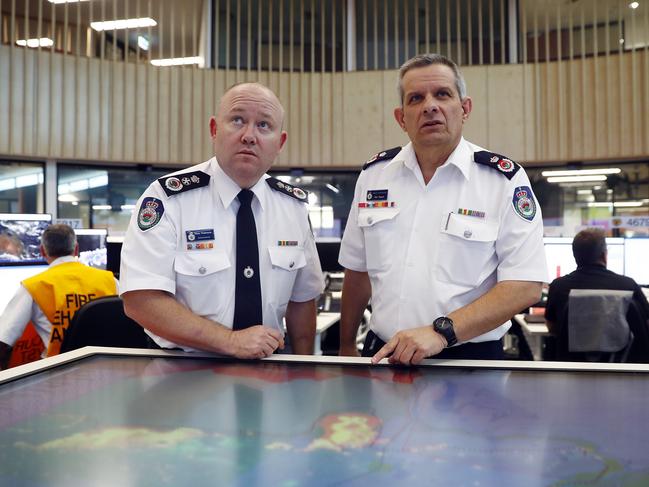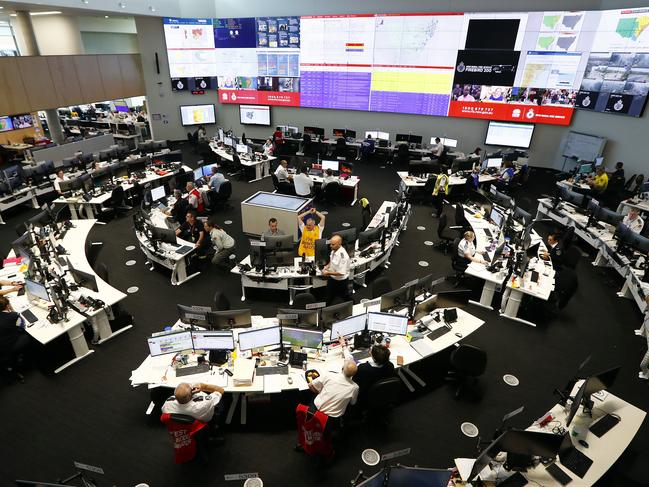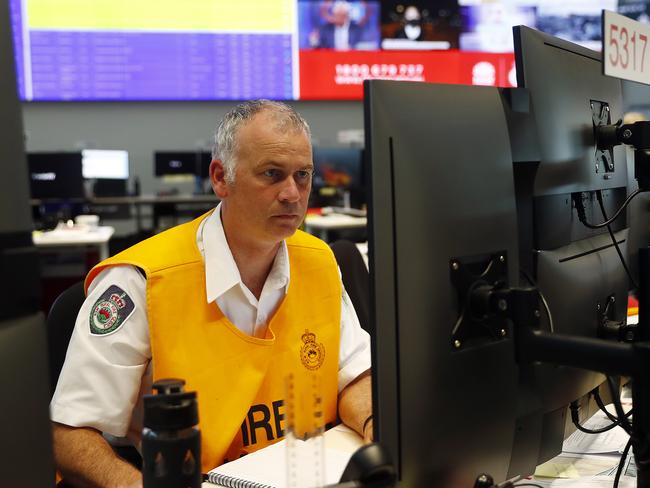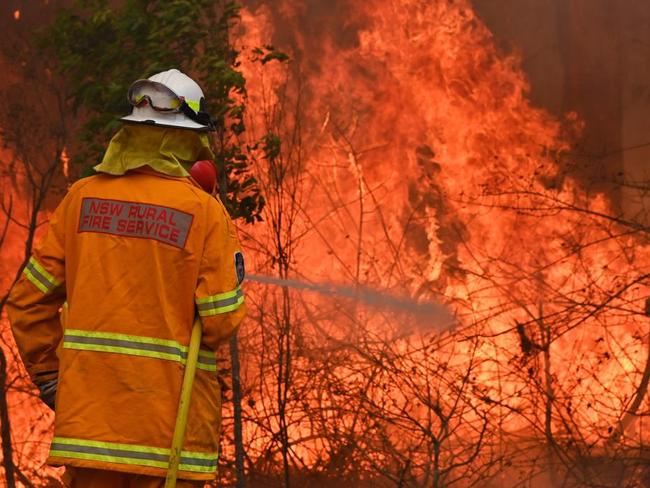Inside the RFS head quarters: the leaders behind the bushfire battle
As fire fighting volunteers battle the flames from the frontline, decisions that change the course of people’s lives are made at the Rural Fire Service epicentre in Sydney. The Sunday Telegraph went behind the scenes.
NSW
Don't miss out on the headlines from NSW. Followed categories will be added to My News.
As bushfires raged across the state last Friday, haunting aerial images were being sent back to the Rural Fire Service nerve centre at Olympic Park.
Seventeen fires were burning at emergency warning level, another 20 were out of control and heartbreaking phone calls from residents trapped by towering flames were streaming in.
Inside the RFS headquarters, line scans — infra-red images captured by aircraft flying high over the fire ground — provided a glimpse of the devastation.
“You start seeing these small bright bits in there and you look at them and you know they are homes burning,” RFS Deputy Commissioner Rob Rogers told The Sunday Telegraph.

“You sit there and think: ‘I just hope there is no one in them’. To me that is the most stressful thing and that is what keeps me awake at night.”
While hundreds of volunteer firefighters fight on the frontline, Mr Rogers is in a core group of decision-makers making the calls that change people’s lives.
MORE FROM AVA BENNY-MORRISON:
Deadly fires: Blaze from hell was pure red evil
Chilling new warning: The worst is yet to come
They decide how to stretch resources across multiple fire grounds, to prioritise one life-threatening fire over another and oversee evacuation orders and emergency warnings.
The room starts buzzing about 6am, when Commissioner Shane Fitzsimmons, who stayed at a hotel nearby at the height of emergency last week to turn his commute into time spent at HQ, arrives for early briefings.

“The reality is I am heavily engaged in a lot of the decisions,” he explained, minutes after the Hillville fire on the Mid North Coast was upgraded to emergency warning level.
“Deliberately so because I want to understand what people are doing but it also hopes give them the confidence and assurance to make those decisions.
“If you want people to make life and death decisions, they have to know they have your backing.”

For senior fire behaviour analyst Simon Heemstra, the days leading up to a catastrophic fire danger period are the most important.
Bushfires are fickle and volatile but it is an analyst’s job to predict the path a blaze will take, how intense it will be and how many lives will be at risk.
The modelling — based on information from the fire front, satellite imaging, line scans and weather forecasts — underpins decisions about how fires will be fought.
On Monday night, as the state braced for catastrophic fire danger the following day, the fire behaviour analyst team compiled a confronting map showing the predicted spread of bushfires towards towns such as Nambucca Heads and Coffs Harbour.

The analysts team’s forecasts also stretch months into the future.
“The climate models are showing significantly high chance of below average rainfall and an almost certainty of above average temperatures,” Mr Heemstra said.
“The season we are going into is a very challenging season.”

Fire modelling is shaped by weather conditions. Like Mr McCoy, it is metrologist Zach Berry-Porter’s job to know what is around the corner.
“We will get the first signs of a bad weather day potentially a week out,” he said.
“But it comes down to particular weather details about nature of timing of wind changes, how strong those winds are going to be and how hot it is going to be.”
When conditions get worse, the RFS equivalent of a bat phone rings loudly.


The phone is impossible to ignore — even if you can’t hear the shrills, the flashing blue light above the phone demands your attention.
In regional towns near fire-impacted areas, such as Armidale and Glen Innes, incident management teams gather information from the crews on the fire front.
When an out-of-control bushfire threatens communities and needs to be upgraded to an emergency warning, the incident controller calls this phone.
On Friday, when bushfires destroyed 150 properties across the Mid North Coast and Northern NSW, the phone rang 28 times.

Usually, it is a RFS state operations controller, like Peter McKechnie or his deputy, Ben Millington, who answer.
Deputy Commissioner Rogers, Commissioner Fitzsimmons and a public information officer stop what they are doing and join a teleconference to discuss, quickly and decisively, the escalating fire threat and how to respond to it.
Incident controllers pitch up their plan, detailing what they need – large air tankers, retardant drops, more boots on the ground, a warning to a small community to seek shelter – and the RFS top brass confirm that decision.
That way, Mr Fitzsimmons explains, the responsibility rests with him, especially if something goes wrong.

Within minutes, the information about the fire threat filters through the room, where representatives from other agencies — health, police, ambulance and transport — are stationed.
The domino effect is the closure of roads, schools, the mobilisation of buses to evacuate residents and deployment of air tankers to battle the blaze from the air.
The scarcity of water has challenged fire fighting efforts this season but preparation is key.
RFS fixed wing aircraft are flying out of Armidale Airport but, given the town’s water shortage, water is trucked in 30,000 litres at a time from the coast.
Even then, water bombing on a hot and windy day could prove useless because it evaporates almost before it hits the ground.
As a bushfire raced towards homes in Turramurra on Sydney’s north shore on Tuesday, Mr McKechnie confirmed the call to drop retardant from a Hercules air tanker.
The strategy works in saving lives and properties — 2100 properties have been saved across the state since fires flared up last Friday — but the retardant coated homes, cars and streets in pink.

“I would rather that we have retardant end up in places we didn’t want, than not have done it and be looking at multiple homes lost to fire,” Mr McKechnie said.
When the fire danger for Sydney, the Hunter and Illawarra regions was at catastrophic level on Tuesday, the RFS had 101 firefighting aircraft in operation.
State Air Desk Inspector Sam Crothers explained a major challenge was juggling competing fires when homes were under threat.

Air tankers, which carry up to 15,000 litres of water, need three to four kilometres of visibility to take off, most aircraft can’t fly in winds over 70 kilometres per hour and heavy smoke prevents even helicopters from reaching communities under threat.
“We are getting tremendous pressure from everywhere, from triple-0 calls that come through to the incident management team saying: ‘Give me aircraft now’,” the aviation operations officer said.
“What we have to be really careful of is we have to sift through the strategies we have in place and see what the highest priority is.”
Originally published as Inside the RFS head quarters: the leaders behind the bushfire battle

